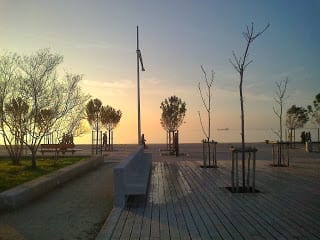Anthony Papagiannis
Thessaloniki, Greece
 |
| Waterfront Promenade, Thessaloniki, Greece. Photograph by the author. |
The contours are quite familiar, both to the eye and the touch. My hand strokes its counterpart, its twin sibling: they have been working together ever since I first saw the light of the day in this world. They have washed, clasped, clapped each other, tugged and pulled and strained together. They cooperate and complement in innumerable tasks, from the elementary to the most elaborate. These lines are typed effortlessly thanks to their harmonious duet, the result of a lifetime of coordinated practice, a fact well known to anybody who plays a musical instrument or operates a complex piece of machinery or drives a car, or simply uses knife and fork. I cannot even tie a shoelace without their joint action.
And yet today that left upper extremity is a complete stranger: it does not belong to me, it is a dead weight. I touch, caress, slap, pinch it with my right hand: there is no feeling at all. It might belong to anybody else but me. I lift it from the wrist and let go: it drops like a stone, along with the full length of the arm from the shoulder down. The whole limb is completely senseless and immobile, with no muscle tone and no communication at all with the rest of my body. You could chop it off, and I would not bat an eyelid. The thought occurs to me that this is how people who have had a stroke must feel. No tactile messages, no movement, no sense of position in space: none of the functions that define a member as “self” and are vital for the integrated daily function of the body.
Thankfully I am not the victim of a stroke. This total alienation of my left limb is the result of a brachial plexus block expertly induced by an anesthetist for an arthroscopy of my shoulder. I spend the idle hours after the procedure checking the gradual restoration of my neural function; I have been told that the effects of the block may last up to twenty hours. Every so often I try to send a movement command to my fingers, but they are still unresponsive.
At some time in the middle of the night I realize that I can trigger a slight flexion twitch in my fingers; extension is still impossible. Pins and needles in my fingertips recall occasions when I had slept on my folded arm which went numb with pressure. By daybreak the hand feels and moves almost normally, but still drops at the wrist and elbow. Little by little function returns from distal to proximal parts of the limb, along with the blessed sensation of postoperative pain, so unpleasant and yet so useful for our continued existence. As the late and great Dr. Paul Brand used to say, “I hurt, therefore I am; thank God for pain!”1
By lunchtime the broken communication has been restored, the muscles have returned to full function, the limb has been reunited with its body, has become “self” again. All in all, a unique and most instructive lesson in neurophysiology.
Reference
- Brand P & Yancey P. Pain: The Gift Nobody Wants. Zondervan 1993
ANTHONY PAPAGIANNIS, MD, MRCP(UK), DipPallMed, FCCP, is a practicing pulmonologist in Thessaloniki, Greece. He graduated from the Aristotle University of Thessaloniki Medical School. He trained in Internal Medicine in Greece and subsequently in the United Kingdom, and specialized in Pulmonary Medicine. He also holds a postgraduate Diploma in Palliative Medicine from the University of Cardiff, Wales, United Kingdom. He is a postgraduate instructor in palliative medicine in the University of Thessaly, Larissa, Greece. He also edits the journal of the Thessaloniki Medical Association, and blogs regularly.
Winter 2020 | Sections | Personal Narratives

Leave a Reply